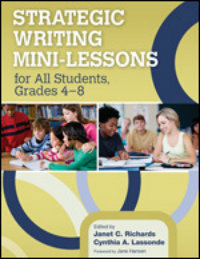Strategic Writing Mini-Lessons
Strategic Writing Mini-Lessons for All Students, Grades 4-8
By Janet C. Richards and Cynthia A. Lassonde
(Corwin: A SAGE Company, 2013 – Learn more)
Differentiation is the hot phrase in education. In Strategic Writing Mini-Lessons for All Students, Grades 4-8, you will find 22 thorough writing mini-lessons on a large variety of topics that include adaptations for struggling writers, English Language Learners and even advanced writers. Each lesson covers all students in your diverse 4-8 class of writers.
An essential question of this book is,
How can we set a solid groundwork so that all students, regardless of skill level, eagerly raise their hands to share their writing at the end of a class?”
To this end, each of the chapters (many written by contributors along with several by the author/editors) covers one mini-lesson with lots of background information and advice for the teacher. The structure is:

• Why This Strategy Is Important
• List of Materials Needed
• Lesson Layout including Sample Discussion
• I Write-We-Write-You-Write
• Student Reflection
• Extend the Strategy Across the Curriculum
• Resources for Further Reading
In my classroom, I found the strategies to be engaging, effective, and practical. The students really enjoyed participating and were able to apply the new knowledge to their own writing.
For example, in the mini-lesson “Creating Rounded Characters Through Cartoon Connections,” author Krishna Seunarinesingh has students create a concept map of a popular cartoon character, in this case SpongeBob SquarePants. She asks her class about how he looks, his personal characteristics, and his relationship with others.
By using a well known character from TV, my class was easily able to brainstorm all sorts of character traits, what characters look like and sound like, how they would react in a specific situation and how they get along with others. When creating a story, students were able to bring so much more life to their characters, and they enjoyed writing about them. At times my students just wanted to list the traits, so we discussed how to weave them into the story or how to “show” instead of “tell.”
Thoughtful adaptations
As a teacher, I found the adaptations part of each lesson to be a true treasure. Oftentimes, adaptations for lower level learners or ELL students can easily be found, but it’s so helpful and unique to find adaptations for advanced writers. I shared my copy of the book with colleagues in general education classrooms and they, too, were impressed with the lessons and the adaptations.
This is not a comprehensive writing curriculum, nor was it intended to be. However, the lessons cover several genres of writing, including persuasive, expository, and narrative. It also touches on prewriting, drafting, revising and editing.
On the front inside cover of the book, there is a handy chart showing the writing Common Core Standards and which mini-lessons cover which standards.
The ideal audience for this book is wide. Whether you work primarily with struggling learners, like me, or your classroom has the typical gamut of learners, you will find lessons and techniques to add to your lesson plans tomorrow.
Danielle McIntosh is a middle school special education teacher at North Tapps Middle School in Lake Tapps, Washington. Her passion for struggling learners in the middle level is evident in her classroom every day. She loves blogging, reading, laughing, and spending time with her husband and two daughters.

































